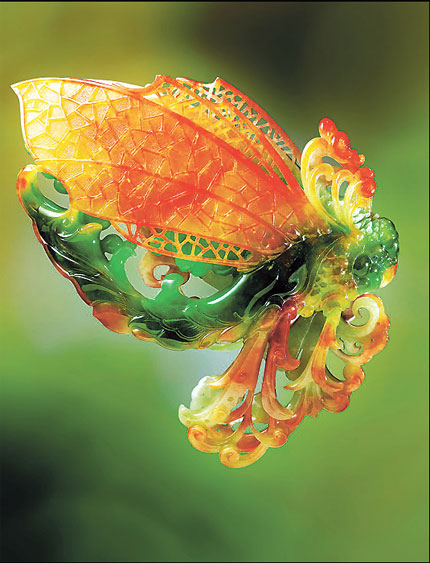 |
|
One of Wang Junyi’s highly praised works is this butterfly shaped from a piece of jadeite that gradually “changes” colors.
|
Many wealthy Chinese today drape themselves in European luxury-brand jewelry made of gold, platinum, diamonds and other glittering gemstones.
By contrast, ancient Chinese of means and taste often preferred creamy white hard jade that did not advertise wealth but symbolized beauty, purity, nobility, perfection, constancy, durability, power and immortality.
Jade was the ultimate understated symbol of luxury.
It is said by Chinese that “gold has value but jade is invaluable.”
The medals at the 2008 Beijing Olympics were set in white jade mined in the Kunlun Mountains of Qinghai province.
Hard jade (jadeite) is difficult to carve and chisel and must be worn away by abrasion, a laborious process. Thus, it was the symbol of power. Jade ornaments and items were used and worn by royalty and nobility.
The history of jade is as long as Chinese civilization; archeologists have found jade objects from the early Neolithic Period (around 5000 BC).
Jade was carved into sacrificial vessels, ornaments, utensils, tools and many other objects. Also a symbol of immortality, jade was buried with the dead and believed to hasten the passage to the next world.
Many funerary objects have been unearthed, including a royal jade burial suit composed of 2,498 pieces of jade, sewn together with gold thread. It encased the body of Liu Seng, ruler of Zhongshan State (113 BC) in the Western Han Dynasty (206 BC-AD 24).
Jade flutes and jade chimes were said to make especially heavenly music.
Confucius (551-479 BC) said jade has 11 virtues. “Its shine and brilliance represent purity and its perfect compactness and extreme hardness represent the sureness of intelligence.”
Because jade stands for beauty, grace and purity, it has been used in many Chinese idioms, such as bing qing yu jie (pure and noble 冰清玉洁) and ting ting yu li (fair, slim and graceful 亭亭玉立). The Chinese character for jade (yu 玉) is often used in women’s names.
Jade was said to have health benefits, such as balancing yin and yang energies and curing disease.
It is generally classified into hard jade or jadeite ying yu (硬玉) and soft jade or nephrite ruan yu (软玉).
Jade’s basic color is creamy white, opaque and waxy. Mineral elements, such as iron, chromium and magnesium, create colors including shades of apple and spinach green, violet, yellow, orange, red, white, brown and black. Generally the value of the mineral is determined by color, intensity, luster, clarity and translucence or transparency.
Jadeite is also called emerald (fei cui 翡翠) because some pieces are deep emerald in color and translucent.
We recommend:
